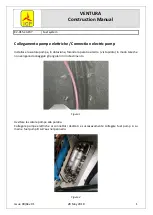
Flying the APUS RS
Section 5
25
fast turn increasing in steepness, which will
eventually become a spiral dive (further
informa
tion on this is in the section “Spiral
Dive
”).
Rapid descent methods
Many flying situations call for a very rapid
descent to avoid a dangerous situation, e.g.
the upcurrent from a cumulus cloud, an
approaching cold front or a storm front.
Rapid descent methods should all be
practised in calm conditions and at sufficient
altitude so that a pilot is then able to employ
them effectively if extreme conditions arise.
The rapid descents are divided into three
different manoeuvres which increase the
sink rate in a safe and controllable manner.
WARNING
Any rapid descent methods other than
those described in this section have not
been tested by SWING.
SWING advises against using any rapid
descent methods other than those
described in this section. In an extreme
situation,
they
could
result
in
uncontrollable flight positions.
Spiral dives
The spiral dive is the most effective method
for making a rapid descent, and can allow
sink rates of up to 20 m/s to be reached. It is
suitable where there is a high ascent rate
and little wind.
The certification tests differentiate between
sink rates over and under 14 m/s. The
APUS RS automatically recovers from the
spiral dive within one turn up to 14 m/s.
Above 14 m/s, it may be necessary to break
the outside half of the wing and/or weight-
shift to the outside to recover from the
spiral. With a sink rate up to 20 m/s and a
neutral position of the pilot, the spiral does
not tighten automatically.
Exiting the manoeuvre at high sink rates can
take several turns.
Given the complexity and the possible risks
of the spiral dive, SWING recommends that
this manoeuvre be learnt under qualified
instruction.
WARNING
In the spiral dive, very high turn speeds
can be reached with an increase in
acceleration due to gravity (up to over
6g), so exercise care when attempting
this manoeuvre. Take note of the
following:
Do not enter the spiral dive by way of a
wingover. High sink rates can be reached
very quickly by doing this. It is not
possible to safely gauge the sink rates.
The APUS RS allows
extreme sink rates
up to 30 m/s
.
Do not continue the spiral dive for too
long:
it
could
cause
a
loss
of
consciousness.
Always maintain
ground clearance of
150
– 200m
.
The manoeuvre must be
exited at this height above ground.
Spiral dives with “big ears” lead to
extreme loading of the open section of the
canopy. This move is prohibited in
Germany.
Starting the manoeuvre
Begin the spiral dive whilst flying at full
speed by flying a turn which becomes
tighter and tighter and by using weight-
shifting to the inside (refer here to “Turns”
also).
The bank angle and sink rate are controlled
by carefully applying or releasing the inside
brake.
Look down before and during the spiral dive
to maintain a constant check on your
distance from the ground.










































